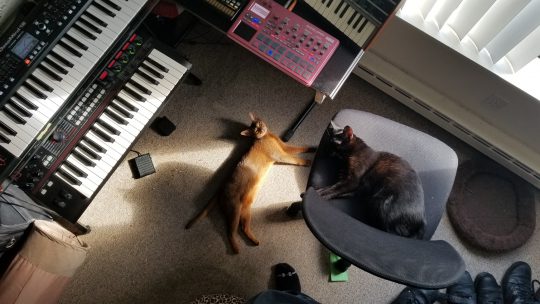
Yoshi (tabby) and Blix (black) are relaxing in the studio. I see a Behringer Deep Mind 12, and Korg R3, Electribe, and Volca Beats. Submitted by Manny Tejeda via our Facebook page.


Yoshi (tabby) and Blix (black) are relaxing in the studio. I see a Behringer Deep Mind 12, and Korg R3, Electribe, and Volca Beats. Submitted by Manny Tejeda via our Facebook page.
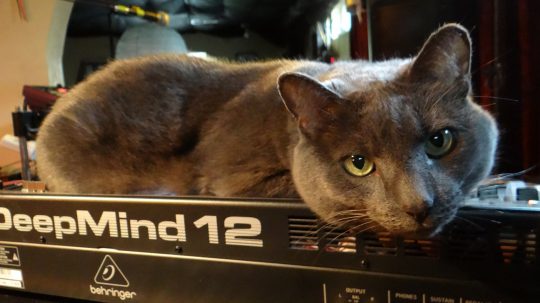
Eliot the cat sits atop a Behringer DeepMind 12, presumably enjoying the warm analog vibes. Submitted by Stiofan Dubh via our Facebook page.
Eliot helps with spacey sounds.
We at CatSynth are sure he is a great studio helper!
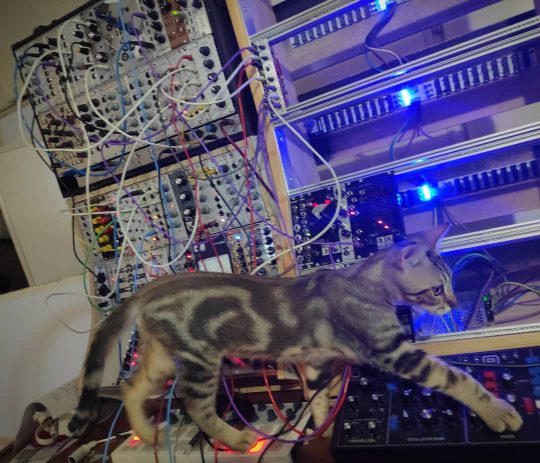
Max, with his lovely marble markings, explores the studio. He is walking past an impressive collection of Eurorack modules, stepping on an Arturia BeatStep, and about to tweak some patches on the Behringer Model D. From coresect23 on Instagram.
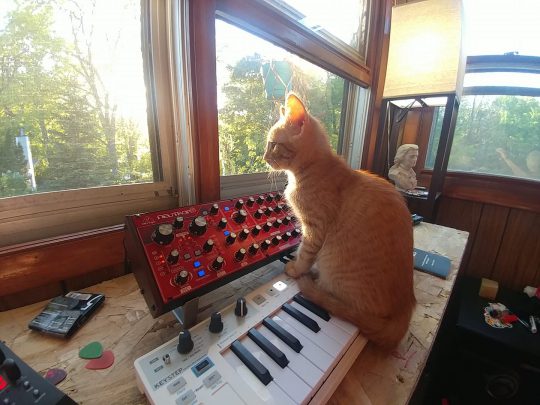
A pretty orange tabby plays some notes on an Arturia Keystep and Behringer Neutron synthesizer. From Karl Garcia via Facebook.
In the middle of a patch this cat just sits down on the keyboard and gets the arpeggiator going lol.
Of all the synthesizers in Behringer’s growing catalog, the Neutron is one of the two that most interests me personally, the other being the new VC340 Vocoder. You can see my encounter with Behringer’s synths before NAMM in this video.
Our 2019 NAMM experience began a little earlier this year when we stopped by Behringer’s offsite event in the Chatsworth neighborhood of Los Angeles. It was an opportunity to check out their current and upcoming synthesizer offerings. You can see some of them in this video.https://www.youtube.com/watch?v=ylvIpER
There is perhaps no synthesizer maker more controversial and more talked about these days than Behringer. Some dismiss them outright, others condemn their cloning of classic instruments, and others applaud their making affordable synthesizers that sound good and play well. Mention them in any synthesizer forum, and you are likely to get more responses than with any other topic.
Overall, I was happy with what I saw from them this year. I particularly liked the Vocoder VC340, a clone of the legendary Roland VP330 vocoder.
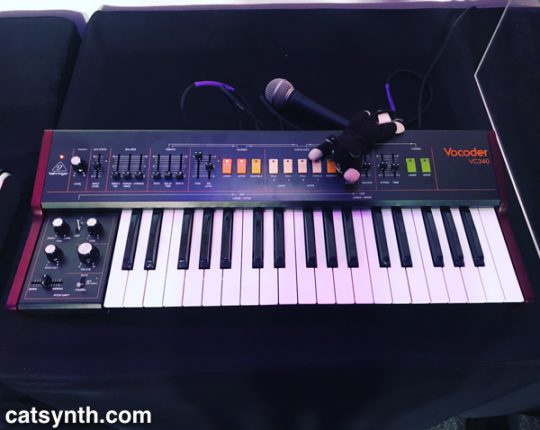
I already own a Roland Boutique VP-03, so I have access to this sound and signal path, with all its temperamental qualities. But the VC340 comes in a larger package with full-size keys, with electronics more similar to the original, including the voice and string synthesizers. It would make a great stage vocoder if I had need and space for one. It is also easier to get external signals into it, and we played around using Behringer’s new Rhythm Designer RD-808 as the modulator signal (you can hear it in the video).
Behringer has also come out with a clone of the Odyssey, simply called Odyssey.
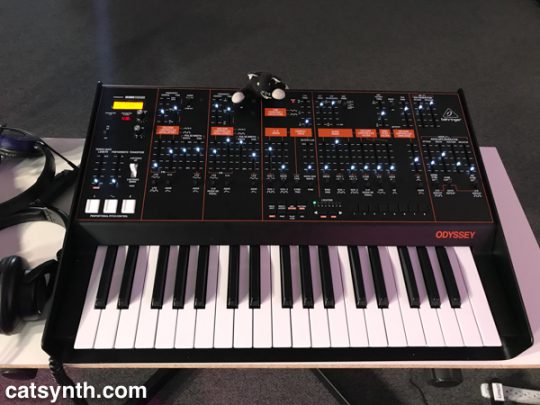
It’s industrial design, font, and colors are remarkably similar to the original (something which probably makes Behringer’s critics howl). But it’s a good sounding unit, and quite rugged looking. The layout of the sliders is a bit different from what I know from the original, the Korg clone, and my Octave CAT, so I didn’t have the opportunity to dial in the “Chameleon” tone and give it the Herbie Hancock test, but I did get some interesting modulated sounds familiar from the original Odyssey.
It is important to note that Behringer has also produced original instruments such as the Neutron.
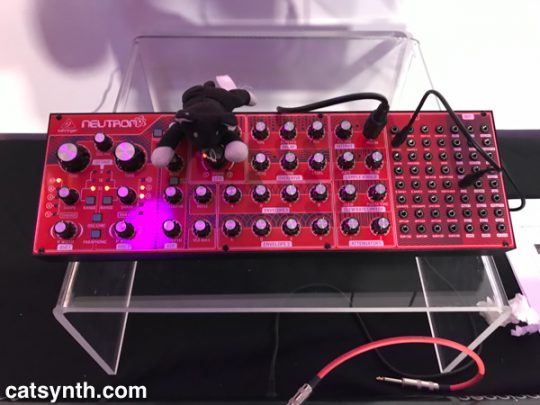
The Neutron is a Eurorack-compatible synthesizer with all the expected VCO, VCF, and VCA sections, as well as an extensive modulation matrix. It does not have a sequencer, but the Eurorack ecosystem is awash with sequencers so that shouldn’t be much of an issue. The Neutron is on the surface similar to the Moog Mother-32 and Arturia Microbrute (sans sequencer), but it does have its own sound. Is it different enough to want it if you already own those instruments? That is subjective. But it played well, and at $399 is quite affordable.
There is also the clone of the Minimoog, the Model D, affectionately known by many of us as “The Boog.”
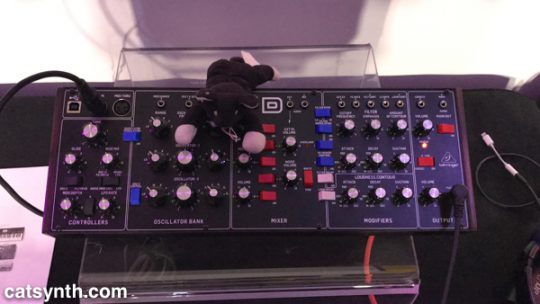
It sounds like a Model D. And it is Eurorack compatible. It’s a great affordable option to get that sound. End of story.
And finally, there is the new MS-101, a clone of the Roland SH-101, complete with red and blue finishes.
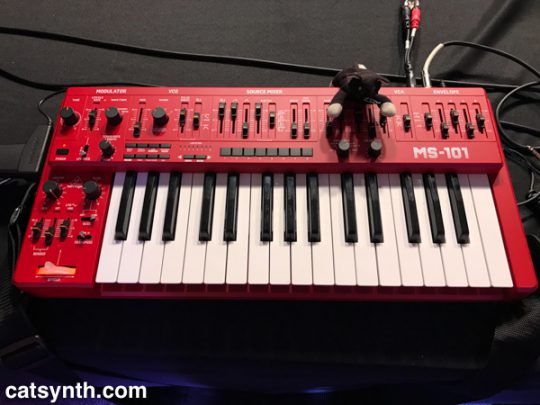
I don’t think the controversies around Behringer will fade anytime soon, especially as they continue to ramp up their synthesizer catalog. For those who complain about their cloning, there are others who charge “elitism” at their critics, considering the high prices vintage instruments and even current Eurorack modules command. Plus, these instruments have MIDI, USB, and other features that are rather handy when making music. We at CatSynth come down somewhere on the outside of this discussion, and simply enjoyed playing the instruments; and we might look into that vocoder.

Meet Zelda the Grey British Blue, who approves of the studio updates that include painted 1U panels, a microKORG, Roland rhythm box, and intriguing little DIY synth in an Altoids box, and more. From skaterdays on Instagram.
Our somewhat drawn-out coverage of NAMM 2017 comes down to two final articles. We would be remiss if one of them did not include the Behringer DeepMind 12.

Perhaps no product was more anticipated and controversial among synthesizer players and enthusiasts this year than the DeepMind 12. A lot of this has to do with Behringer’s history and reputation in some parts of the industry, as well as the intense hype and frequent teasers last year. But as an instrument, the DM12 stands on its own. It has rather impressive specs including two DCOs, VCA, VCF and multiple LFOs and envelopes for each of its 12 voices. It connects to a PC or tablet to control all onboard parameters – something we at CatSynth think is a nice touch. And it has a professional-looking industrial design, with an attractive front panel and wooden-looking sides.
In terms of sound and playing, it felt like an “ordinary” analog poly synth and reminded me a bit of a Juno or the popular Korg Minilogue. It doesn’t have the distinctive or super-intense sound of a Moog synth or a classic Prophet or Oberheim, which seem to pack more punch sonically into fewer oscillators. The DM12 seems to sound it’s best doing stacked voices rather than at 12-voice polyphony, but this might be my bias for intense timbral-rich sounds. So if one already has an analog synth from one of those legendary makers, the DM12 probably won’t hold as much personal appeal. But it does seem like a convincing choice as a “first” analog polyphonic synth and something to bring to gigs, especially if one needs a variety of classic synth pads and 80s-esque sounds in one’s music. It also is a little less intimidating to program than some other poly synths. And of course the $999 USD price tag is much less than a high-end mono synth or most analog poly synths. Those who were excited about the Minilogue and similar instruments will probably want to check this out as well.
iPad docks seem to be a theme this year at NAMM. Basically, these are high-end iPad shells that provide audio and MIDI I/O functionality. Consider the iStudio from Behringer.

The iPad fits into the dock and serves both as the computer and screen. The dock provides several controls one would find in a small portable studio and then a host of standards I/O ports on the back, including XLR, 1/4″ audio, video and MIDI.

But no sooner had I encountered the Behringer model than I came across a very similar one from Alesis:

Here, the Alesis iO Dock is controlling the Korg iMS-20 iPad Synth. Like the Behringer, it has XLR, MIDI, unbalanced audio and video. They even both have footswitch inputs.
So which one is better? It’s not really something I can say. They seem more focused on people who want to use their iPad as a workstation rather than as a live instrument the way I do, which requires being able to move it freely (and switch to portrait mode) and lift it show to the audience. But now that several companies are coming out with docks, maybe we will see more variations.